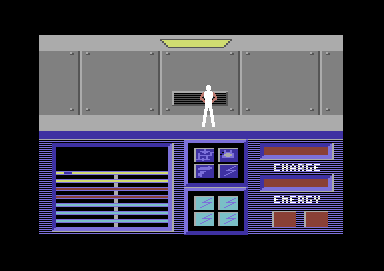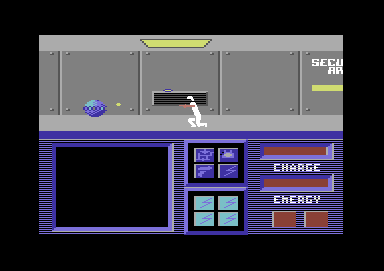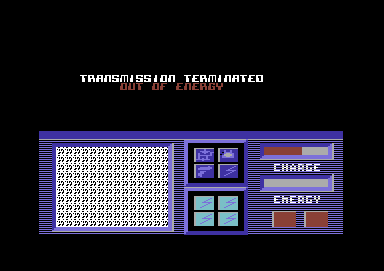Retro Replay Review
Gameplay
Android Control delivers a tense and methodical gameplay loop that emphasizes exploration and resource management. As the player navigates the twenty floors of the alien spacecraft via the central elevator, every decision carries weight. The limited eight-floor map display forces you to plan your route carefully, deciding which areas to explore first and which to revisit later once you’ve unlocked new abilities or gathered more supplies.
(HEY YOU!! We hope you enjoy! We try not to run ads. So basically, this is a very expensive hobby running this site. Please consider joining us for updates, forums, and more. Network w/ us to make some cash or friends while retro gaming, and you can win some free retro games for posting. Okay, carry on 👍)
Combat encounters are sparse but impactful. Equipped with a straight- and diagonal-firing gun plus a handful of safety-armed bombs, the android must choose the right tool for each enemy type. Quick reflexes help in close-quarters hallways, while strategic bomb placement becomes critical against clusters of foes or tougher alien constructs. Because ammunition and explosives are scarce, every shot counts and encourages cautious, almost puzzle-like engagements.
Puzzle mechanics add an extra layer of depth. The zap pulse system requires you to manipulate and override alien circuits by channeling energy until the amp-meter flashes. Timing is crucial: linger too long in an exposed corridor and you risk running into reinforcements, or worse, losing power before completing the override. This blend of action and cerebral challenge keeps the pacing dynamic and gives each floor a distinct rhythm.
Recharge stations act as safe havens where you can replenish energy, gun charges, and zap pulses. Their strategic placement encourages you to map out your progress in detail, weighing the risk of backtracking against pressing forward into uncharted territory. Overall, Android Control’s gameplay loop strikes a solid balance between combat, exploration, and puzzle-solving, making each elevator ride an exercise in anticipation.
Graphics
Visually, Android Control embraces a retro-futuristic aesthetic with crisp sprite work and minimalist UI elements. The color-coded floors not only serve as visual landmarks but also reinforce the game’s design philosophy of clarity over clutter. Each section of the craft—engine room, laboratory, living quarters—boasts its own palette, making it easy to orient yourself as you ascend or descend.
Character and enemy sprites are well-animated, with smooth transitions between idle, firing, and damaged states. The android’s sleek silhouette contrasts nicely with the more organic designs of the alien creatures, reinforcing the “machine versus organism” theme. Environmental details, such as sparking conduits and flickering lights, add atmospheric tension without overwhelming the screen.
The circuitry puzzles feature a simple but effective visual representation of amps and energy flow. Watching the pulse travel through wires and over nodes gives a satisfying, almost tactile sense of completion once you reach the exit terminal. Although there’s no flashy 3D rendering, the polished 2D visuals are supremely functional and never obscure the gameplay.
Subtle lighting effects, such as dim corridors that brighten when you approach recharge stations, heighten the mood and help guide the player’s eye. Occasional cutscenes—depicted via sharp black-and-white illustrations—add narrative context without derailing the game’s forward momentum. Overall, the graphics serve the gameplay perfectly, creating an immersive sci-fi atmosphere on a modest technical budget.
Story
Android Control opens with a gripping premise: a mysterious spaceship lands near a small American town, its inhabitants vanish, and three elite agents never return. This setup immediately hooks you with unanswered questions and a palpable sense of dread. The storyline unfolds through brief audio logs, environmental clues, and the android’s own mission directives, maintaining a tight narrative focus throughout.
As the sole operative aboard the alien craft, the android’s objective is clear: discover the aliens’ intentions and neutralize the threat if necessary. Despite the android’s mechanical nature, the game subtly builds empathy by framing its mission as humanity’s last hope. Every corridor you clear and every circuit you override drives home the sense that you’re racing against an invisible clock.
Plot twists are sprinkled sparingly but effectively. A midway revelation about the aliens’ true motives reframes earlier encounters, forcing you to question whether aggressive action is always the answer. These moments of moral ambiguity elevate the narrative beyond a standard “shoot-or-die” scenario, especially when paired with optional logs that offer insight into the vanished townspeople and the scientists’ growing unease.
By the final floors, the story reaches a tense climax as you piece together the aliens’ grand design. The resolution, delivered in a concise after-action report, leaves enough questions unanswered to fuel post-game discussions while still providing a satisfying conclusion. In this way, Android Control balances mystery and payoff, ensuring that curious players feel rewarded for their persistence.
Overall Experience
Android Control offers a compelling blend of exploration, combat, and puzzle-solving that feels both classic and fresh. Its deliberate pacing encourages careful planning and rewards methodical play, while occasional action sequences keep the tension high. Whether you’re backtracking to recharge or nervously lining up a diagonal gunshot, the game keeps you engrossed from start to finish.
The sound design complements the visuals perfectly. Sparse background hums and distant alien growls build suspense, while the satisfying beep of a successful circuit override or the muffled thud of a recharge station adds tactile feedback. The minimalist score swells at key moments, emphasizing high-stakes encounters and narrative reveals without overshadowing the gameplay.
Replay value lies in discovering optional logs, tackling floors in a different order, and experimenting with alternate combat strategies. Speedrunners will appreciate the tight level design and the ability to optimize every route, while casual players can savor the world-building and atmospheric details at a more leisurely pace. On both ends of the spectrum, Android Control caters to diverse playstyles.
Ultimately, Android Control is a satisfying sci-fi adventure that proves you don’t need cutting-edge graphics or over-the-top set pieces to deliver a memorable experience. With its polished 2D art, engaging puzzles, and suspenseful story, it stands out as a thoughtful, well-crafted title that will appeal to fans of exploration-driven action games. If you’re looking for a game that combines tight design with atmospheric intrigue, this android’s mission is one you won’t want to miss.
 Retro Replay Retro Replay gaming reviews, news, emulation, geek stuff and more!
Retro Replay Retro Replay gaming reviews, news, emulation, geek stuff and more!








Reviews
There are no reviews yet.